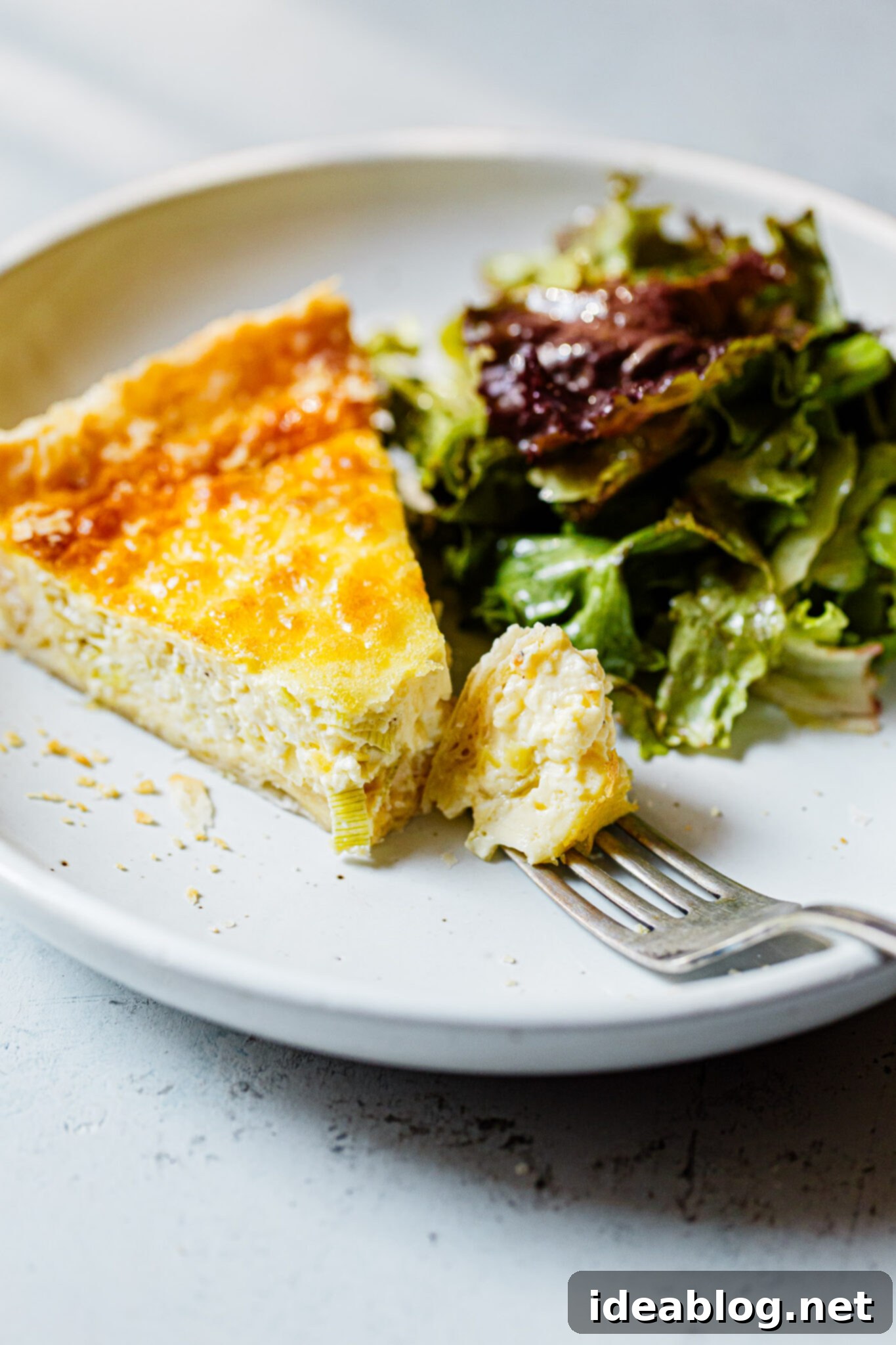Mastering the Art of Gruyère Leek Quiche: A Classic French Recipe for Silky Custard and Flaky Crust Perfection
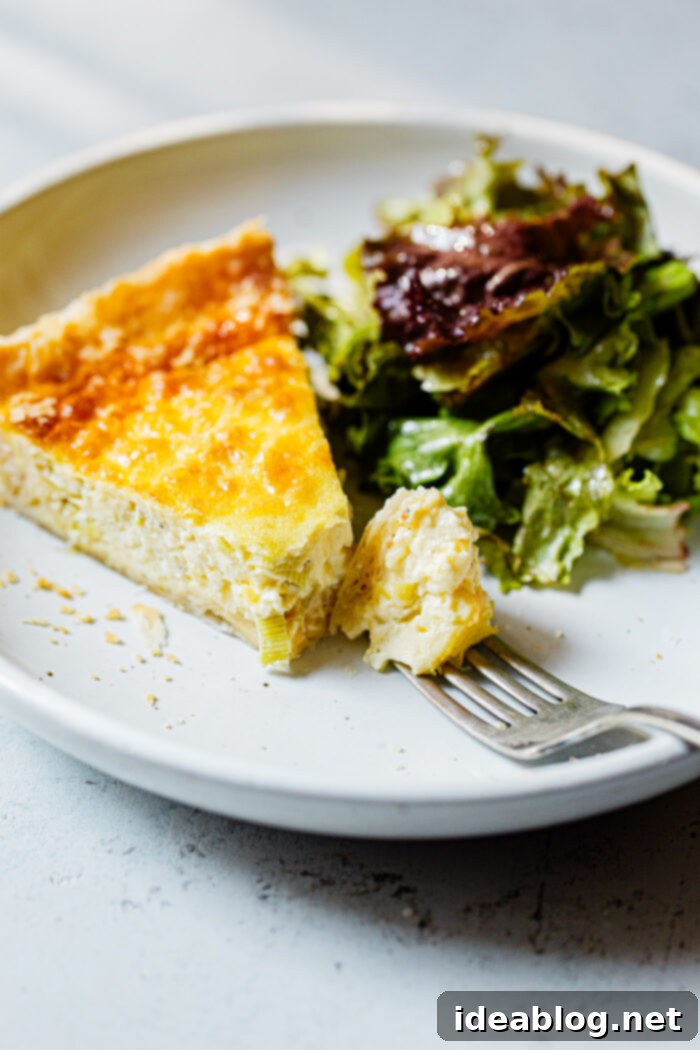
There’s an undeniable allure to a truly exceptional quiche. Imagine a classic French quiche, boasting a **tender, rich, and undeniably decadent custard** nestled within a **golden, impossibly flaky crust**. When served alongside a crisp, fresh green salad, it transcends a simple meal, becoming a culinary experience that easily ranks among my all-time favorites. It’s the kind of dish that evokes memories of charming French bistros and comforting home-cooked meals.
However, many quiches fall short, leaving us with a rather unmemorable, sometimes even disappointing, experience. This common pitfall might explain why this beloved savory tart is often overlooked or, worse, underrated in the culinary world. But a properly made quiche is a revelation, a perfect balance of savory flavors and textures.
My passion for quiche runs deep, and after years of perfecting various recipes, I’m finally thrilled to share this outstanding Gruyère Leek Quiche. This recipe isn’t just another quiche; it’s a culmination of lessons learned during my time in French culinary school and countless hours spent experimenting in my own kitchen. It features my signature all-butter flaky quiche crust, along with essential tips and techniques that guarantee a truly authentic and unforgettable result.
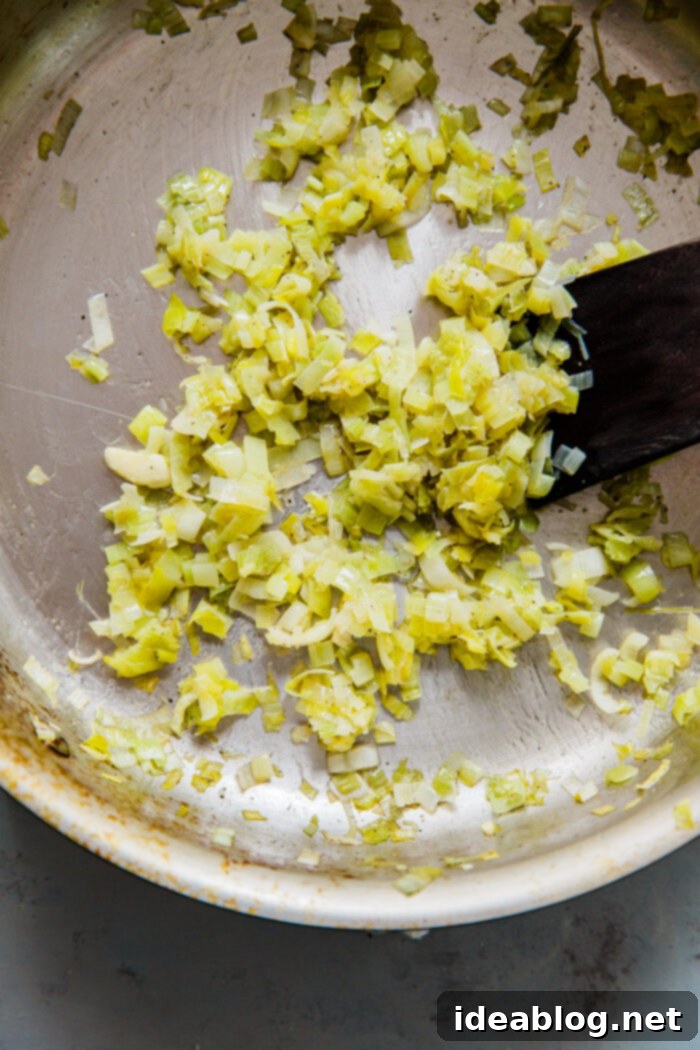
Why This Gruyère Leek Quiche Will Become Your New Favorite:
- Unparalleled, Silky Custard Texture: The secret to achieving a remarkably silky, tender, and melt-in-your-mouth savory custard lies in baking it low and slow. This classic Gruyère Leek Quiche is carefully baked at a moderate 325°F (165°C). This gentle cooking method is crucial because proteins, such as those found in eggs, remain significantly more tender and retain far more fat and moisture when cooked at lower temperatures, as opposed to rapid, high-heat baking. The goal is a custard that is **just set**, firm around the edges, but still exhibits a delicate, almost imperceptible jiggle in the very center. This indicates perfect doneness and ensures a luxurious texture.
- Remarkably Convenient for Meal Prep and Reheating: While crafting a homemade quiche takes a bit of time and effort, the excellent news is that it reheats magnificently! This makes it an ideal candidate for make-ahead meals. Prepare this indulgent quiche over the weekend, and you’ll have quick, delicious breakfasts, lunches, or even light dinners ready throughout the busy week. To further streamline your cooking process, consider preparing and freezing your quiche crust days, weeks, or even months in advance. This single step can drastically cut down on your prep time on baking day. Additionally, you can get a significant head start by prepping your fillings, such as sautéing vegetables like leeks and grating the Gruyère cheese, several days before assembling and baking.
- Infinitely Adaptable to Your Taste: This Gruyère Leek Quiche recipe serves as a versatile canvas, inviting you to customize it to your heart’s content. Feel free to swap the delicate leeks for an array of other sautéed or roasted vegetables. Fantastic alternatives include earthy mushrooms, vibrant broccoli florets, tender asparagus spears, sweet caramelized onions, or even spinach (ensure it’s thoroughly drained). For those who appreciate a heartier, more savory profile reminiscent of a Quiche Lorraine, consider adding crispy, crumbled bacon or pancetta. Don’t shy away from experimenting with fresh herbs to brighten the flavors – dill adds a lovely freshness, parsley provides a subtle green note, and fresh thyme offers a wonderful earthy aroma. The fundamental principle for substitutions is to use a similar volume of ingredients and, critically, to cook down any fresh vegetables beforehand to significantly reduce their water content. This prevents a watery custard and ensures a perfectly set quiche.
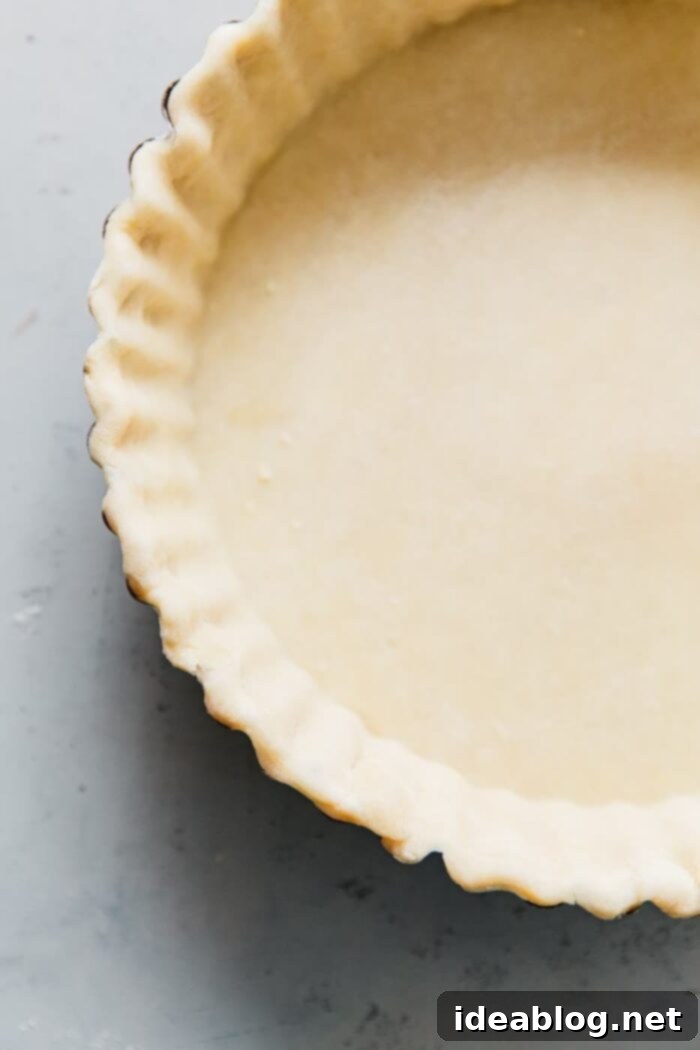
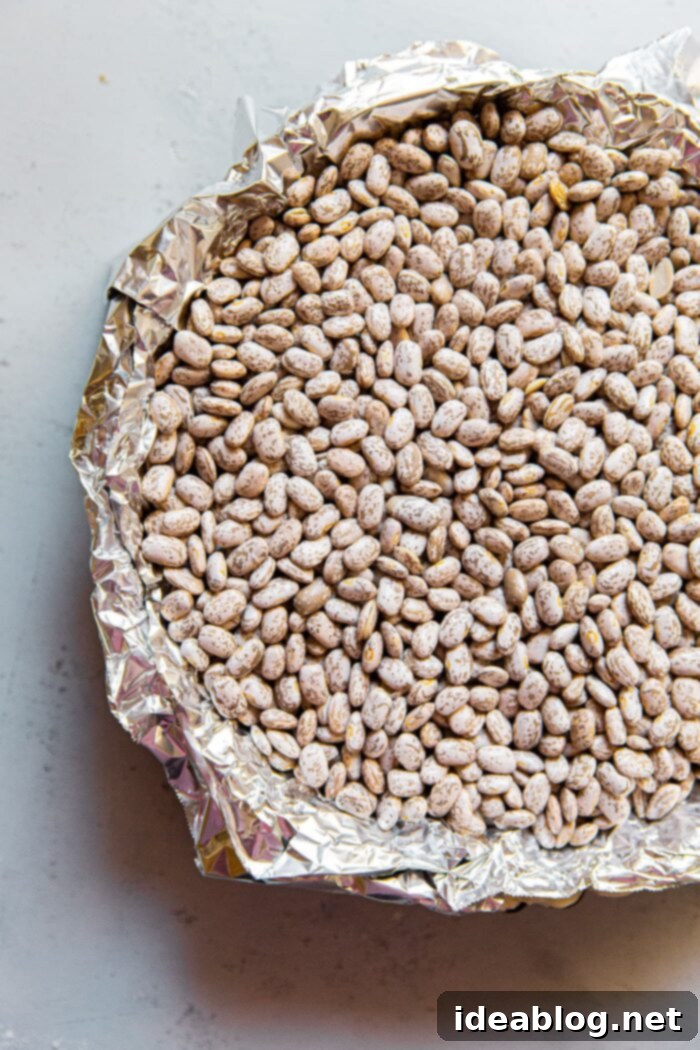
Key Components for an Authentic Gruyère Leek Quiche:
- The Essential Prebaked Crust – The foundation of any superior quiche is an impeccably prebaked (or blind-baked) crust. This crucial step is non-negotiable, as it ensures that your crust maintains its structural integrity and remains wonderfully sturdy and flaky, never becoming soggy, even when filled with the rich, loose custard. This specific quiche recipe thoughtfully incorporates my favorite quiche crust recipe, which is renowned for yielding a consistently flaky, golden-brown crust that, importantly, resists shrinking during baking. This allows it to comfortably hold a generous and satisfying volume of the luxurious custard.
- Rich Gruyère Cheese – When it comes to selecting cheese for quiche, Gruyère is simply unmatched. Celebrated for its complex, rich, and nutty flavor profile, alongside its exceptional meltability, it’s my unequivocal top choice. The way it melts seamlessly into the custard, adding depth and a slight tang, is truly sublime. If Gruyère is unavailable, a high-quality aged sharp cheddar makes a very good alternative, offering a robust flavor that complements the leeks beautifully. Other good options include Comté or Emmental.
- Sweet, Sautéed Leeks – Leeks are a key player in this quiche, offering a delicate, slightly sweet onion flavor that is more refined and nuanced than regular yellow onions. Sautéed until they are exquisitely soft, translucent, and slightly caramelized, the leeks nearly melt into the baked custard, becoming an integral part of its tender texture. To prepare them, trim the dark green tops and the root end, then slice them lengthwise and thinly. Wash them thoroughly under cold running water, separating the layers to remove any trapped dirt or grit, as leeks can be surprisingly sandy. If you prefer or need a substitute, finely diced and sautéed shallots, sweet yellow onion, or even tender green onions (scallions) can be used, ensuring they are cooked until very soft to reduce moisture.
- The Decadent Egg Custard – This quiche distinguishes itself with an authentic French egg custard, meticulously prepared with the classic ratio of **1 large egg to 1/2 cup of rich heavy cream**. Believe it or not, a true French quiche is proportionally more cream than egg, and this precise balance is paramount. It’s this generous amount of heavy cream that contributes to the exceptionally silky, smooth, and tender filling that defines a superior quiche. To enhance the flavor complexity, I always incorporate freshly grated nutmeg, which adds a warm, subtly spiced aroma, and a touch of Dijon mustard. The Dijon doesn’t make the quiche taste like mustard; instead, it acts as a secret ingredient, brightening the flavors and adding a hint of tang that beautifully balances the richness. Please refer to the detailed notes on dairy substitutions further below.
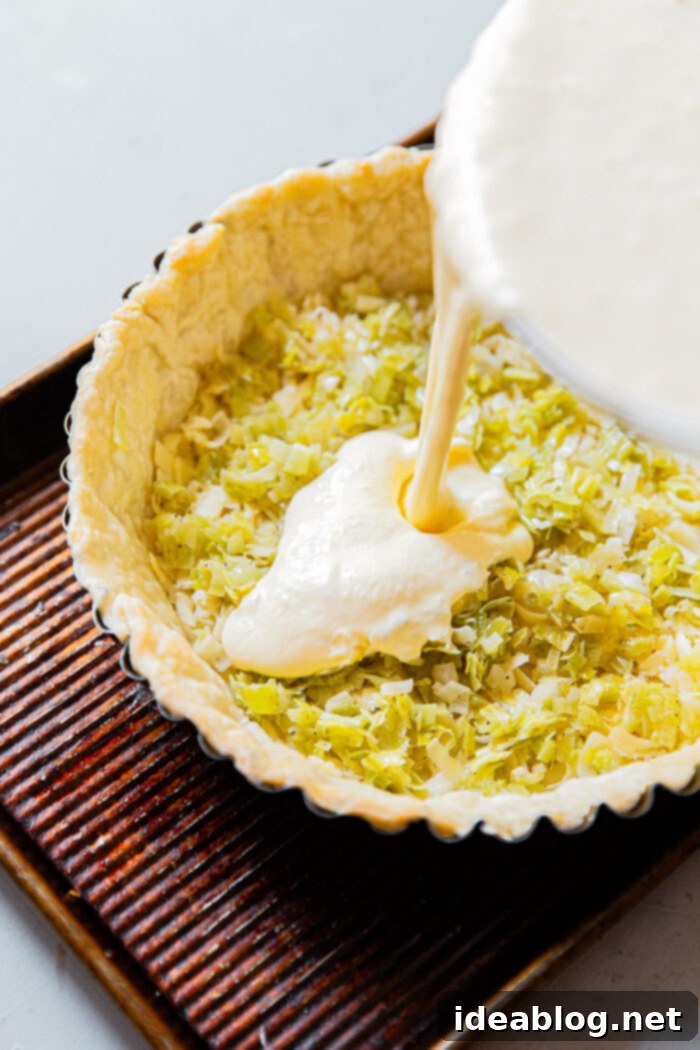
Can I Substitute Heavy Cream with Other Dairy in Quiche?
While having options is always appealing in cooking, there’s a very specific and important reason why classic French quiches traditionally rely on heavy cream, and often, quite a generous amount of it. The fundamental principle boils down to the **dairy fat content** and its profound influence on the quiche’s overall flavor, luxurious texture, and delightful mouthfeel.
Heavy cream is a powerhouse of richness, boasting a fat content that typically exceeds 35%. This is a dramatically higher percentage compared to the meager 3.5% fat found in whole milk. This significant difference in fat content is not merely a preference; it’s a critical factor, especially when crafting delicate egg custards like those in a classic quiche. The fat in heavy cream prevents the egg proteins from curdling and becoming rubbery, ensuring a smooth, velvety texture.
Of course, opting for whole milk or a combination of milk and cream is technically possible. However, it’s important to set realistic expectations: these alternatives will simply not deliver the same level of sublime texture, richness, or depth of flavor that heavy cream provides. It’s crucial to remember: this recipe aims for an authentically classic French quiche, characterized by its tender, rich custard – it is most definitely not intended to be a light frittata or a leaner egg bake. Our unwavering goal here is to create an exceptional, truly classic quiche that is worth every ounce of effort and time invested, delivering an unparalleled taste and texture experience.
Still contemplating swapping the heavy cream for something lighter? If you absolutely insist on a dairy substitute, you may consider using half-and-half (which has a fat content between whole milk and heavy cream). However, be fully prepared for a noticeable difference in the final texture; the custard will be less rich and may have a slightly firmer set. I strongly advise against using whole milk for this specific recipe. This quiche has been meticulously tested and developed, and whole milk will simply not yield the desired exceptionally tender and silky results that define this classic French preparation. Stick to heavy cream for the best possible outcome.
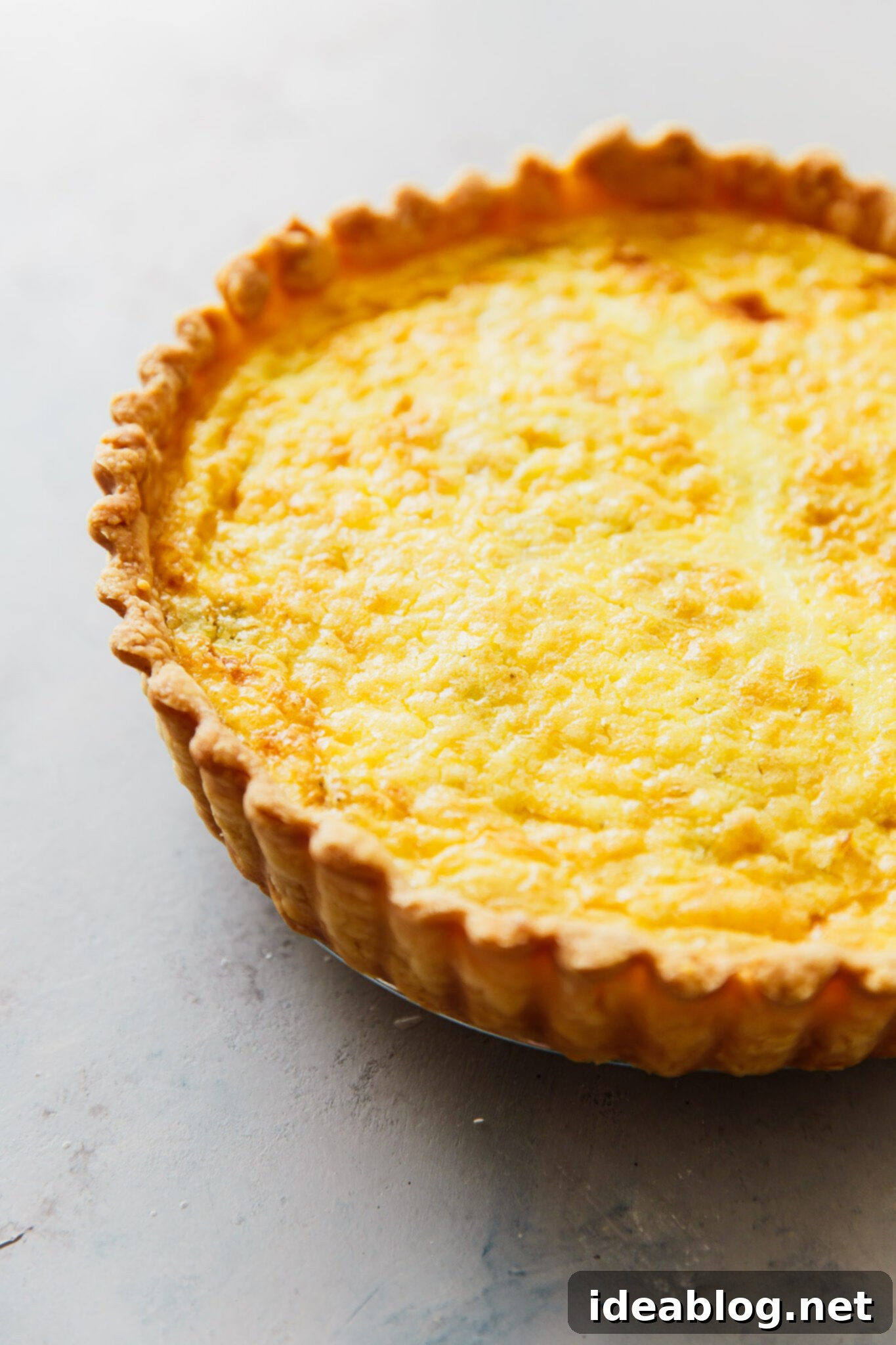
Storing and Reheating Your Classic Leek Quiche:
One of the many benefits of this classic Gruyère Leek Quiche is how wonderfully it stores and reheats, making it perfect for meal planning. To store leftover quiche, simply cover it tightly with plastic wrap or aluminum foil and place it in the refrigerator for up to 5 days. For longer storage, quiche freezes exceptionally well for up to 3 months.
When freezing, it’s often best to cut the quiche into individual slices first. This allows for easier portioning and faster reheating later. Wrap each slice tightly in aluminum foil, then place the wrapped slices in a freezer-safe Ziplock bag or an airtight container to prevent freezer burn. There’s no need to thaw frozen quiche before reheating.
To reheat for optimal taste and texture, preheat your oven to 325°F (165°C). Arrange slices of quiche (or the whole quiche, if desired) on a parchment-lined baking sheet. Cutting the quiche into individual portions before reheating will significantly speed up the warming process and ensure even heating. Bake for approximately 15 to 25 minutes, with the exact time depending on the thickness and size of your slices, until the quiche is heated through to the center and the crust is crisp again. For a whole quiche, this could take 30-45 minutes. Serve immediately and enjoy the comforting flavors anew!
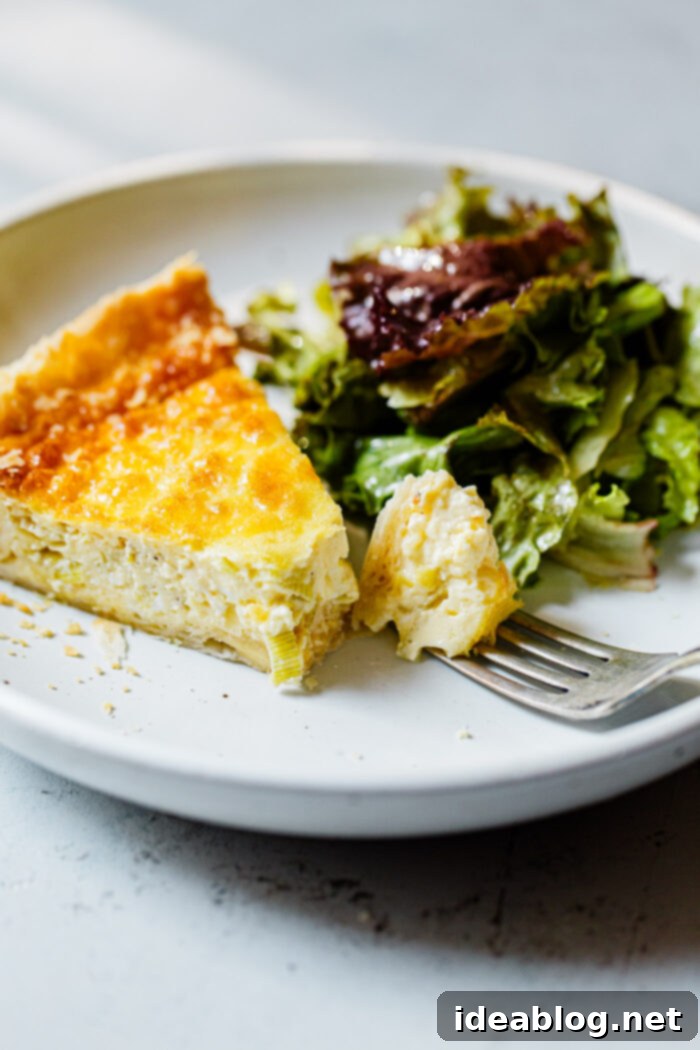
Serving Suggestions for Your Perfect Quiche:
This versatile Gruyère Leek Quiche is a delight at any time of day – whether enjoyed for a luxurious breakfast, a satisfying lunch, or an elegant dinner. My absolute favorite way to serve quiche is alongside a vibrant, crisp leafy green salad. The freshness and lightness of the salad provide a beautiful contrast to the rich, creamy custard of the quiche.
For the best balance, I highly recommend tossing your salad with a bright and acidic vinaigrette. A simple yet effective choice is this easy lemon vinaigrette, which I frequently use. The acidity of the dressing cuts through the richness of the quiche’s custard and Gruyère cheese, preventing the meal from feeling too heavy and instead leaving you feeling perfectly satisfied. Other excellent accompaniments could include a light tomato soup, roasted asparagus, or even some thinly sliced cured meats for an extra touch of savory flavor.

Gruyère Leek Quiche
Ingredients
For the Crust:
- 1 9-Inch Prebaked Quiche Crust (ensure it’s deep enough to hold the generous custard)
For the Leek & Gruyère Filling:
- 1 large leek, white and light green parts only (approx. 200g) thoroughly cleaned, sliced lengthwise and thinly sliced crosswise into half-moons
- 1 tablespoon (15g) unsalted butter
- 1 tablespoon (15 ml) extra virgin olive oil
- ½ teaspoon kosher salt (for seasoning leeks)
- 2 ounces (60g) grated Gruyère cheese (freshly grated for best flavor and melt)
For the Silky Egg Custard:
- 4 large eggs (ensure they are large, not medium or extra-large)
- 2 cups (480 ml) heavy cream (full-fat for the authentic silky texture)
- 1 teaspoon Dijon mustard (adds a subtle tang and enhances flavor)
- ¾ teaspoon kosher salt (or to taste)
- ¼ teaspoon freshly grated nutmeg (essential for classic flavor; can substitute with freshly ground black pepper for a different profile)
Instructions
- Important Note on Crust Depth: This recipe is designed for a 9-inch prebaked quiche crust that is on the deeper side, allowing for a generous and satisfying filling. You can certainly prepare this quiche using a more shallow tart or pie pan, but please be aware that it will most likely not accommodate the full volume of the rich custard prepared in this recipe. If using a shallower pan, you have two options: either reduce the amount of custard proportionally (maintaining the classic ratio of 1 whole egg to ½ cup cream for optimal texture) or bake any leftover custard in a small ramekin separately (to create a delightful crustless quiche!) at 325°F (165°C) until it is just set and tender.
- Preheat Oven: Begin by preheating your oven to a gentle 325°F (165°C). Ensure an oven rack is positioned in the center. Carefully place your prebaked quiche crust (still in its tart pan) onto a rimmed sheet pan. This will make it easier to transfer in and out of the oven and will catch any potential drips. Set it aside for assembly.
- Sauté the Leeks to Perfection: In a medium-sized skillet, combine the unsalted butter and extra virgin olive oil over medium-low heat. Once the butter has fully melted and begins to bubble lightly, add the thinly sliced leeks. Sprinkle them evenly with ½ teaspoon of kosher salt. Cook the leeks, stirring frequently and gently, until they become beautifully soft, tender, and translucent, which typically takes about 10 to 12 minutes. Avoid browning them too much. If the pan appears to be getting dry or the leeks start to gain too much color, add a small splash (about a tablespoon) of water as needed to help them steam and soften. Once cooked, transfer the tender leeks to a small bowl and allow them to cool slightly while you prepare the creamy custard.
- Craft the Silky Custard: In a separate medium-sized bowl, gently whisk together the 4 large eggs, 2 cups of heavy cream, 1 teaspoon of Dijon mustard, ¾ teaspoon of kosher salt, and ¼ teaspoon of freshly grated nutmeg. Whisk just until the mixture is smooth and well combined – be careful not to over-whisk and incorporate too much air, as this can lead to a bubbly or less silky custard.
- Assemble and Bake Your Masterpiece: Begin by evenly sprinkling the freshly grated Gruyère cheese onto the bottom of your prebaked crust. Next, distribute the cooled, sautéed leeks in an even, thin layer over the cheese. Carefully and slowly pour the prepared egg custard over the leeks and cheese; it should rise to just about reach the top edge of your crust. With utmost care, transfer the sheet pan with the quiche to the preheated oven. Bake for approximately 40 to 55 minutes, or until the top is lightly golden brown, and the custard is set around the edges but still exhibits the slightest, delicate jiggle in the very center when gently nudged. This slight jiggle is the hallmark of a perfectly cooked, tender custard. Once baked, remove the quiche from the oven and set it on a wire rack to cool for 10 to 15 minutes before attempting to slice. This resting period allows the custard to fully set and makes for cleaner slices. Serve your exquisite Gruyère Leek Quiche warm or at room temperature.
Flavor Variation Ideas for Your Quiche:
- This recipe is wonderfully versatile, inviting you to make it uniquely your own. Instead of leeks, consider swapping in other sautéed or roasted vegetables. Delicious options include:
- Mushrooms: Sauté sliced mushrooms until golden brown and their moisture has evaporated.
- Broccoli: Blanch small broccoli florets until tender-crisp, then pat dry.
- Asparagus: Roast or blanch chopped asparagus tips until tender.
- Spinach: Sauté fresh spinach until wilted, then squeeze out all excess water thoroughly to prevent a soggy quiche.
- Caramelized Onions: Slow-cook thinly sliced yellow onions until deeply golden and sweet.
Substitution Notes for Dairy:
- Heavy cream is truly the star when it comes to achieving that signature, exceptionally silky texture and rich flavor in a classic French quiche. It boasts a fat content typically exceeding 35%, which is significantly higher than whole milk’s approximate 3.5% fat. This substantial difference in fat content is critical, especially for preventing egg proteins from tightening too much and for creating a tender, luxurious custard. While opting for whole milk or a half-and-half (a milk-cream blend) is possible, please understand that these substitutes will not yield the same superior texture or profound flavor. This recipe is crafted for a classic French quiche, designed to be rich and indulgent, not a light frittata. Our aim is to achieve an authentically classic quiche that truly stands out in taste and texture, making the time and effort invested utterly worthwhile. For the best, most authentic result, heavy cream is strongly recommended.
